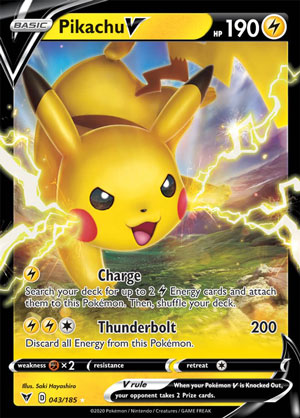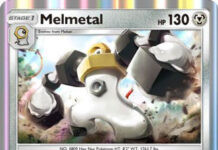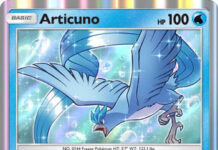
Card – Vivid Voltage
Date Reviewed: January 20, 2021
Ratings Summary:
Standard: 1.50
Expanded: 1.75
Ratings are based on a 1 to 5 scale. 1 is horrible. 3 is average. 5 is great.
Reviews Below:

Vince
Pikachu is to Vivid Voltage whereas Charizard is to Darkness Ablaze. Pikachu has cemented to be a chase card, and the market price from TCGplayer shows.
Anyways, there’s actually two versions of Pikachu-V (one from the set and the other which is a promo), so I’ll cover both of them to determine which one are better stepping stones to evolve into Pikachu V-MAX. Both today’s card and the promo has the same stats: A basic Lightning type with 190 HP, Fighting weakness, and a retreat cost of one, and two attacks. For today’s card, it has Charge and Thunderbolt. Charge costs L and lets you search your deck for 2 Lightning energies and attach it to this Pokémon, which is a good lead to follow up on its second attack, which costs LLC for 200 damage while discarding all energies attached to it. For the promo version, it has Pika Ball and Circle Circuit. Pika Ball costs L for 30 damage while Circuit Circuit costs LL and does 30 damage times the amount of Benched Pokemon you have in play; the most you can do is 150 damage with a full Bench, or 240 damage in Expanded if you have a full Bench with Sky Field active.
For today’s card, I don’t think Pikachu can be considered as an attacker despite Thunderbolt doing a lot of damage. Forcing you to discard all energy attached to it means that Thunderbolt isn’t something to be repeatedly used reliably, and even Tapu Koko (*) can’t replenish all of your energies back, and even with Thunder Mountain (*) you’re still behind in one energy. Only use Thunderbolt when you can OHKO something via Weakness. As for the promo version, Circle Circuit was first seen on Raichu from XY, and it has seen some competitive success at the time. It’s attack cost CC for 20x, but it was enough to OHKO important targets like Yveltal-EX and others weak to Lightning. Pikachu-V’s cost of LL makes it not very splashable, though with Thunder Mountain (*), Circle Circuit’s cost will be L instead, which might be easy to manually attach, but still not as splashable without variants of Rainbow Energy. Unfortunately, the damage multiplier of 30x is not enough; if I were to OHKO Lapras VMAX, I have to also attach Vitality Band to secure it.
Both today’s card and the promo version has decent attacks, but they can evolve into something big, and we’ll save that suspense for another day!
Ratings (Vivid Voltage version):
Standard: 2
Expanded: 2.5
Ratings (Black Star Promos version):
Standard: 2
Expanded: 2.5
Those cards may pull its own, but they’re mostly stepping stones to evolve into something big, and we’ll get to that later through the week. Stay tuned!

Otaku
You can guess what we’re reviewing Friday if we’re looking at Pikachu V (SW – Vivid Voltage 043/185, 170/185). As a Pokémon V, Pikachu V gives up an extra Prize when KO’d, is excluded from certain pieces of support, and is subject to certain Pokémon V counters. All the negative comes with the positives of Pikachu V having a lot more HP and potentially better effects than baseline Pikachu cards. Pikachu is a [L] type, which is good; they lost some of their best support at the last rotation, but still kept Speed [L] Energy and Tapu Koko {*}, as well as proven attackers such as Pikachu & Zekrom-GX. [L] Weakness can sometimes be handy, and [L] Resistance is rare and Expanded-only. As a Basic Pokémon, there’s no waiting to evolve and Pikachu V requires minimal deck space. It can even serve as your opener, though that may not always be a good thing. This also means there’s a natural synergy with certain effects, access to Basic Stage support, but you’ll have to deal with some anti-Basic effects as well.
190 HP is low for a Basic Pokémon V, but a little higher than cards like Crobat V. Certain damage amounts seem common in the TCG, and 200 is one of them… but 190 does easily beat others like 120 or 160. In other words, Pikachu V isn’t sturdy for a Pokémon V but is as good or better than most single Prize Pokémon. Which includes having over twice the HP of its biggest baseline Pikachu counterpart. In fact, it is just 20 under being triple the size of the biggest Pikachu (70 HP), and three or more times the size of the rest. [F] Weakness should be bad, but I haven’t seen Fighting popping up in the top cut for the few semi-recent events. No Resistance is technically the worst, but -30 damage in a single match-up doesn’t usually mean much. The Retreat Cost of [C] is good, though; easy to pay even without other assists.
Pikachu V knows the attacks “Charge” and “Thunderbolt”. The former is priced at [L], and lets Pikachu V attach up to two [L] Energy cards from your deck to itself. For [LLC], Thunderbolt does 200 damage but you must discard all Energy from Pikachu V. They form a pretty basic simple combo that can OHKO most single Prize Pokémon, at least, that lack various defensive buffs. Most old-school Basic Pokémon-EX and Basic Pokémon-GX (sans TAG TEAMs, of course) also fall in one shot. Not most Basic Pokémon V, though, and that is a concern. There is a reason most attack-based Energy acceleration is used as a backup or opening play; once things get going, it can be hard to actually pull off even such a straightforward tactic. At least Pikachu V being unlikely to survive a third turn means the discard cost is largely irrelevant, but remember you’re ultimately averaging 100 damage for one Energy attachment from your hand.
That sounds good, but there’s a decent chance Pikachu V doesn’t survive to actually use Thunderbolt, so you do zero damage for one Energy, effectively discard two basic Lightning Energy cards from your deck (as Pikachu V cannot attach to anything but itself with Charge), and give up two Prizes. Fortunately, Pikachu V can evolve into Pikachu VMAX, which we’ll be reviewing Friday. This option definitely helps Pikachu V, but it is still just a stepping stone to what you might really want to play. There is also some hope because it seems unlikely we’ll only see a single version of Pikachu VMAX, given that Pikachu is the face of the game. In fact, we have another Pikachu V we might as well address: SW – Black Star Promo SWSH063.
This promo Pikachu V has the state stats as today’s version, but two different attacks. “Pika Ball” does 30 for [L]; boring at best, and too weak at worst. “Circle Circuit” actually has some potential, thought its asking price of [LL] is a bit much. Circle Circuit does 30 damage per Pokémon on your Bench, so it maxes out at 150 in Standard. While less than today’s Pikachu V’s Thunderbolt, filling your Bench and getting even two [L] Energy cards attached in a single turn is easier than getting three [L] Energy attached, so I believe it is the better attack. Sky Field expands your Bench capacity to eight in Expanded, appropriately enough, so such a deck can swing for up to 240 damage. While the [LL] is easier to meet here, I’d rather the cost was [CC] not only for use with Double Colorless Energy, but because then it might work to add a [L] attacker to decks already making use of Snorlax VMAX and Zoroark-GX. Assuming such decks still exist.
Ratings
- Standard: 1/5
- Expanded: 1/5
Yes, this is a harsh score for Pikachu V (SW – Vivid Voltage 043/185, 170/185), but we’re not short for good, strong [L] type attackers in actual Lightning decks, and I prefer the promo version I ought to have scheduled for an official double review. For the record, even the promo Pikachu is probably clocking in at only two-out-of-five for Standard and Expanded; until I see proof I am just hopeful it can still slip into some Sky Field decks.
We would love more volunteers to help us with our Card of the Day reviews. If you want to share your ideas on cards with other fans, feel free to drop us an email. We’d be happy to link back to your blog / YouTube Channel / etc. 😉Click here to read our Pokémon Card of the Day Archive. We have reviewed more than 3500 Pokemon cards over the last 17+ years!



